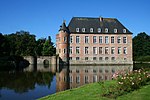
Kassel is a city on the Fulda River in northern Hesse, in central Germany. It is the administrative seat of the Regierungsbezirk Kassel and the district of the same name, and had 201,048 inhabitants in December 2020. The former capital of the state of Hesse-Kassel, it has many palaces and parks, including the Bergpark Wilhelmshöhe, which is a UNESCO World Heritage Site. Kassel is also known for the documenta exhibitions of contemporary art. Kassel has a public university with 25,000 students (2018) and a multicultural population.

The Château de Vincennes is a former fortress and royal residence next to the town of Vincennes, on the eastern edge of Paris, alongside the Bois de Vincennes. It was largely built between 1361 and 1369, and was a preferred residence, after the Palais de la Cité, of French kings in the 14th to 16th century. It is particularly known for its "donjon" or keep, a fortified central tower, the tallest in Europe, built in the 14th century, and for the chapel, Sainte-Chapelle de Vincennes, begun in 1379 but not completed until 1552, which is an exceptional example of Flamboyant Gothic architecture. Because of its fortifications, the château was often used as a royal sanctuary in times of trouble, and later as a prison and military headquarters. The chapel was listed as an historic monument in 1853, and the keep was listed in 1913. Most of the building is now open to the public.
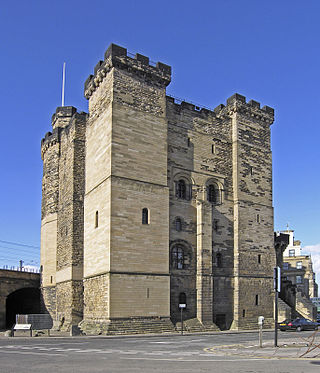
The Castle, Newcastle, or Newcastle Castle is a medieval fortification in Newcastle upon Tyne, England, built on the site of the fortress that gave the City of Newcastle its name. The most prominent remaining structures on the site are the Castle Keep, and the Black Gate, its fortified gatehouse.

Lenzburg Castle is a castle located above the old part of the town of Lenzburg in the Canton of Aargau, Switzerland. It ranks among the oldest and most important of Switzerland. The castle stands on the almost circular castle hill, which rises approximately 100 m (330 ft) over the surrounding plain but is only about 250 m (820 ft) in diameter. The oldest parts of the castle date to the 11th century, when the Counts of Lenzburg built it as their seat. The castle, its historical museum and the castle hill with its Neolithic burial grounds are listed as heritage sites of national significance.

Orava Castle is a castle situated on a high rock above Orava river in the village of Oravský Podzámok, Slovakia. The castle was built in the Kingdom of Hungary, with the oldest parts being built in the thirteenth century and the most recent parts in the early seventeenth century. Many scenes of the 1922 film Nosferatu were filmed here, the castle representing Count Orlok's Transylvanian castle.

Christiansborg Palace is a palace and government building on the islet of Slotsholmen in central Copenhagen, Denmark. It is the seat of the Danish Parliament, the Danish Prime Minister's Office, and the Supreme Court of Denmark. Also, several parts of the palace are used by the Danish monarch, including the Royal Reception Rooms, the Palace Chapel and the Royal Stables.
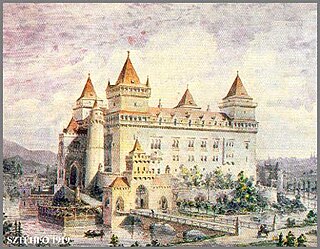
The Castle of Diósgyőr is a medieval castle in the historical town of Diósgyőr which is now part of the Northern Hungarian city Miskolc. The first Castle of Diósgyőr was built probably in the 12th century and was destroyed during the Mongol invasion (1241–42). The current, Gothic castle was built after the invasion and reached the peak of its importance during the reign of King Louis the Great (1342–1382). Later it became a wedding gift for the queens of Hungary, which it remained until the Ottoman invasion of Hungary in the 16th century. By the end of the 17th century it was already in ruins. Archaeological excavations were made from the 1960s. In 2014 the castle was restored; the rooms are furnished with Mediaeval-style furniture.

The Vilnius Castle Complex is a group of cultural, and historic structures on the left bank of the Neris River, near its confluence with the Vilnia River, in Vilnius, Lithuania. The buildings, which evolved between the 10th and 18th centuries, were one of Lithuania's major defensive structures.

Chęciny is a town in Kielce County, Świętokrzyskie Voivodeship, southern Poland, with 4,361 inhabitants as of December 2021. It was first mentioned in historical documents from 1275, and obtained its city charter in 1325. At that time was one of major urban centers of northern Lesser Poland.

Ljubljana Castle is a castle complex standing on Castle Hill above downtown Ljubljana, the capital of Slovenia. It is a key landmark of the town. Originally a medieval fortress, it was probably constructed in the 11th century and rebuilt in the 12th century. It acquired its present outline with an almost complete overhaul in the 15th century, whereas the majority of the buildings date to the 16th and 17th centuries. Initially a defense structure and since the first half of the 14th century the seat of the lords of Carniola, it was since the early 19th century used for various other purposes and today is used as a major cultural venue.
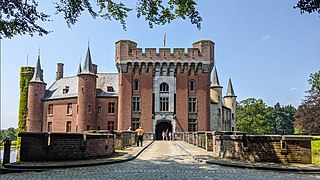
Wijnendale Castle is a historic residence in Wijnendale, West Flanders in Belgium which was once a medieval castle. The present buildings largely date to a nineteenth century restoration, though parts of the north wing still date to the fifteenth century. One wing is currently inhabited by the present owners of the castle, while another is open to the public as a museum.

Vrchlabí is a town in Trutnov District in the Hradec Králové Region of the Czech Republic. It has about 12,000 inhabitants. It lies at the foot of the Giant Mountains on the river Elbe. The town centre with the castle complex, monastery complex and town park is well preserved and is protected by law as an urban monument zone.

Hellenstein Castle is located 70 meters (230 ft) above the city of Heidenheim an der Brenz in eastern Baden-Württemberg, Germany. It was once the home of the Lords of Hellenstein.

The Castles of Bellinzona are a group of fortifications located around the town of Bellinzona, the capital of the Swiss canton of Ticino. Situated on the Alpine foothills, the group is composed of fortified walls and three castles named Castelgrande, Montebello and Sasso Corbaro. Castelgrande is located on a rocky peak overlooking the valley, with a series of walls that protect the old city and connect to Montebello. Sasso Corbaro, the highest of the three castles, is located on an isolated rocky promontory south-east of the other two. The Castles of Bellinzona with their defensive walls have been an UNESCO World Heritage Site since 2000.

Torre del Mar is a locality on the southern coast of Spain, part of the municipality of Vélez-Málaga, Axarquía, located in the province of Málaga.

Lielstraupe Castle is a castle in Straupe Parish, Cēsis Municipality, in the Vidzeme region of Latvia. It was originally built by the von Rosen family in the 13th century and the village of Straupe began to develop around the castle in the 14th century, a large tower was added around 1600 and expropriated soon after. Latter reacquired and remodeled into the baroque style in the 18th century and remained inhabited until being expropriated from Hans von Rosen in 1939.

Sigulda Medieval Castle ruins are located on the edge of the Gauja valley in Latvia. The original castle was built in 1207 as a castellum type fortress, later rebuilt into a convent type building. The residence of the Land Marshal of the Livonian Order since 1432.
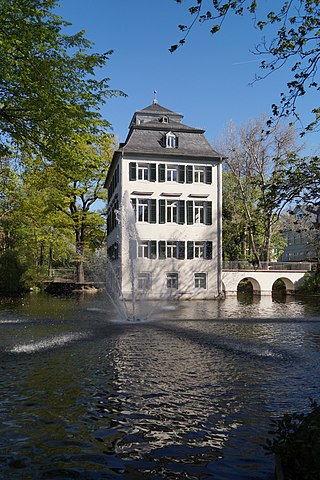
The Holzhausenschlösschen is a moated former country house built by the patrician Holzhausen family on their farm, then just north of Frankfurt and now in the city's Nordend. The present building was completed in 1729, built for Johann Hieronymus von Holzhausen on the foundations of a moated castle from the Middle Ages after a design by Louis Remy de la Fosse. Today, it serves as a venue for cultural events.
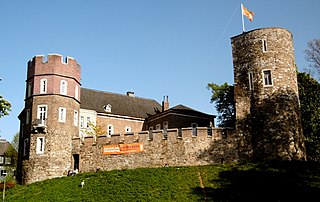
The Frankenberg Castle is a castle in the Frankenberg area of Aachen-Mitte, itself a district of Aachen, Germany. Its name comes from the concept of a "Franke", which was a type of castle that did not owe fealty to any others. Of course, shortly after its construction, the lowland castle became a fief of a Graf, and later belonged to the Duchy of Jülich-Cleves-Berg.
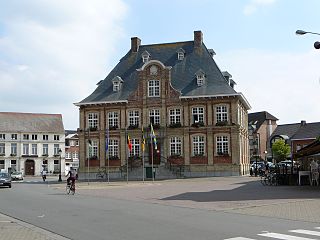
The City Hall of Torhout, West Flanders, Belgium, was the residence of the mayor and the bench of aldermen during their meetings up until the completion of the new City Hall in 2014. It is located on the market square in the city center.






















